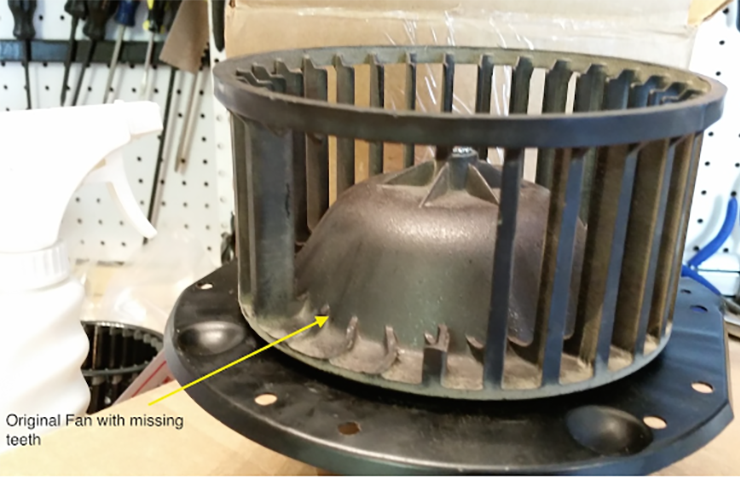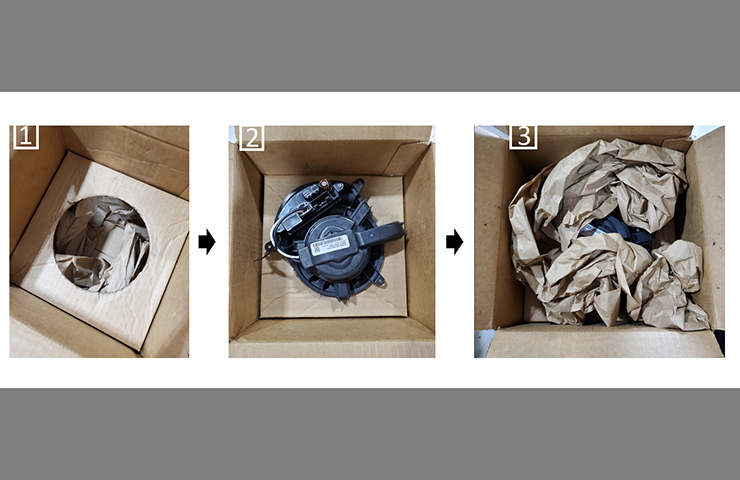Many times, common warranty repairs like HVAC blower motor replacements require that the part be returned to GM. Just like other vehicle components that are returned under warranty, HVAC blower motors are analyzed at the Warranty Parts Center (WPC) to determine the root cause of the failure in order to help resolve product issues. However, if the returned parts are damaged during return shipping, they cannot be properly tested.
It’s critical that the parts arrive at the WPC in the same condition as removed from the vehicle. Missing or broken teeth on a fan, for example, is a common occurrence of damage that occurs during shipping. (Fig. 1)
 Fig. 1
Fig. 1
Use Original Containers
When returning parts under warranty, dealerships are strongly encouraged to use the original packaging and packaging orientation of the new part whenever possible to ship back the failed part. The original packaging will help to properly protect the part during shipment.
Packaging recommendations include: (Fig. 2)
- Placing half of the packing paper from the service box underneath the cardboard mounting shelf to protect the returned motor assembly’s fan.
- Placing the returned motor assembly as shown. Ensure that the motor assembly rests flush to the cardboard mounting shelf.
- Placing the other half of the packing paper from the service box on top of the returned motor assembly as shown.
 Fig. 2
Fig. 2
TIP: Be sure to remove or cover all previous labeling on the box prior to re-use to reduce the possibility of shipping errors.
Replacement blower motor assemblies are fragile components that require containers that properly support and protect the blower motor during shipment. Parts travel a long way and pass through many hands as they travel from the supplier to the Customer Care and Aftersales warehouse, and then to dealerships. Motors returned under warranty without suitable packaging (or no packaging at all) puts the parts at risk for damage during shipping. These damaged components limit the ability to properly test a failed component, which makes it difficult to identify the failure mode — and most importantly — to improve the quality and durability of the component.
Return Guidelines
In addition to using the proper packaging and shipping container when returning parts, the following parts return guidelines are recommended:
- Clearly mark or circle the area of concern on the part, such as a leak, crack, premature wear or defect. The area of defect should be clearly marked and not defaced so that it is easily identifiable.
- When identifying parts, be sure to do so in a way that will not damage the part being sent back. For example, do not wrap a label or metal tag wire around wiper blade inserts or apply tape around door seals.
- Return the actual failed part. Do not send a similar or new part.
- Do not remove any pieces from the part being sent back.
- All parts related to the repair procedure covered by the labor operation on the part return request should be returned together.
- All parts related to a specific labor operation should be bundled together and shipped in one box.
- Do not send multiple returns in the same box. Ship each individual return in a separate box with its unique GWM shipping label affixed on the top of the box and on one outward-facing side. Include inside the package the GWM parts return shipping label, job card with technician comments, and other related documentation to so that the parts can be successfully routed and analyzed.
- Use only clean, dry boxes to return parts. Boxes that have absorbed oil or other fluids should not be used to return parts to the WPC.
- Parts must not be shipped loose. Be sure to package parts using bubble wrap or other protective packing materials to avoid damage during shipping when needed. Do not use any packaging material that may contaminate the part.
For additional information on parts returns, refer to Bulletin #99-00-89-019Y.
– Thanks to Scott Jesnig and Bob Carley


















